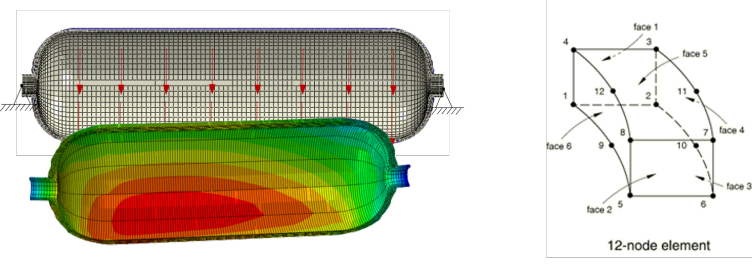
Cylindrical Elements?
What are they and what do they have to do with COPVs?
First of all, cylindrical elements are 3D continuum finite elements, but have an axisymmetric twist to them. They were developed in Abaqus for the tire industry to help efficiently model the deformation of a tire as it presses against the road. The physics of tires, as well as the FE analysis of tires, is remarkably similar to that of COPVs. Both structures have orthotropic reinforcing that is laid to result in nearly axisymmetric behavior. Also, both structures are often loaded axisymmetrically, followed by some type of non-axisymmetric, three dimensional loading.
Referring to the figure of element above the edges of first order cylindrical element in the cross-section has two nodes, but edges in the swept (hoop) direction have three nodes. This is an efficient use of the degrees of freedom, essentially behaving as a first order element in-plane, but as a second order element in the hoop direction. As with all second order elements, the proper use of the element requires a smooth strain gradient in the second order (hoop) direction. This makes cylindrical elements ideal for applications such as the inflation of tires, or the bending of long tube cylinders.
Cylindrical elements are often mixed with brick elements. For example, the regions with large strain gradients near the foot print of a tire, or the ground impact area of a COPV, are modeled with first order brick elements. The regions around the circumference with the smoother strain gradient are modeled with cylindrical elements.
 COPV Drop Test in Abaqus/Explicit
I’ll bet you didn’t know tires and COPVs had so much in common. Thankfully, many years ago a huge amount of work was performed in Abaqus for the tire industry. That work is now being leveraged by WoundSim to perform three dimensional analyses of COPVs efficiently and accurately – typically 4 times faster that equivalent brick models. Contact us at sales@qustomapps.com to learn more.
COPV Drop Test in Abaqus/Explicit
I’ll bet you didn’t know tires and COPVs had so much in common. Thankfully, many years ago a huge amount of work was performed in Abaqus for the tire industry. That work is now being leveraged by WoundSim to perform three dimensional analyses of COPVs efficiently and accurately – typically 4 times faster that equivalent brick models. Contact us at sales@qustomapps.com to learn more.
 COPV Drop Test in Abaqus/Explicit
I’ll bet you didn’t know tires and COPVs had so much in common. Thankfully, many years ago a huge amount of work was performed in Abaqus for the tire industry. That work is now being leveraged by WoundSim to perform three dimensional analyses of COPVs efficiently and accurately – typically 4 times faster that equivalent brick models. Contact us at sales@qustomapps.com to learn more.
COPV Drop Test in Abaqus/Explicit
I’ll bet you didn’t know tires and COPVs had so much in common. Thankfully, many years ago a huge amount of work was performed in Abaqus for the tire industry. That work is now being leveraged by WoundSim to perform three dimensional analyses of COPVs efficiently and accurately – typically 4 times faster that equivalent brick models. Contact us at sales@qustomapps.com to learn more. 